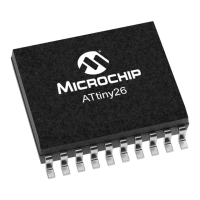113
ATtiny26(L)
1477G–AVR–03/05
Chip Erase The Chip Erase will erase the Flash and EEPROM
(1)
memories plus Lock bits. The Lock
bits are not reset until the program memory has been completely erased. The Fuse bits
are not changed. A Chip Erase must be performed before the Flash and/or EEPROM
are reprogrammed.
Note: 1. The EEPROM memory is preserved during Chip Erase if the EESAVE Fuse is
programmed.
Load Command “Chip Erase”
1. Set XA1, XA0 to “10”. This enables command loading.
2. Set BS1 to “0”.
3. Set DATA to “1000 0000”. This is the command for Chip Erase.
4. Give XTAL1 a positive pulse. This loads the command.
5. Give WR
a negative pulse. This starts the Chip Erase. RDY/BSY goes low.
6. Wait until RDY/BSY
goes high before loading a new command.
Programming the Flash The Flash is organized in pages, see Table 52 on page 109. When programming the
Flash, the program data is latched into a page buffer. This allows one page of program
data to be programmed simultaneously. The following procedure describes how to pro-
gram the entire Flash memory:
A. Load Command "Write Flash"
1. Set XA1, XA0 to “10”. This enables command loading.
2. Set BS1 to “0”.
3. Set DATA to “0001 0000”. This is the command for Write Flash.
4. Give XTAL1 a positive pulse. This loads the command.
B. Load Address Low byte
1. Set XA1, XA0 to “00”. This enables address loading.
2. Set BS1 to “0”. This selects low address.
3. Set DATA = Address low byte ($00 - $FF).
4. Give XTAL1 a positive pulse. This loads the address low byte.
C. Load Data Low Byte
1. Set XA1, XA0 to “01”. This enables data loading.
2. Set DATA = Data low byte ($00 - $FF).
3. Give XTAL1 a positive pulse. This loads the data byte.
D. Load Data High Byte
1. Set BS1 to “1”. This selects high data byte.
2. Set XA1, XA0 to “01”. This enables data loading.
3. Set DATA = Data high byte ($00 - $FF).
4. Give XTAL1 a positive pulse. This loads the data byte.
E. Repeat B through D until the entire buffer is filled or until all data within the page is
loaded.
While the lower bits in the address are mapped to words within the page, the higher bits
address the pages within the FLASH. This is illustrated in Figure 59 on page 114. Note
that if less than 8 bits are required to address words in the page (pagesize < 256), the
most significant bit(s) in the address low byte are used to address the page when per-
forming a page write.

